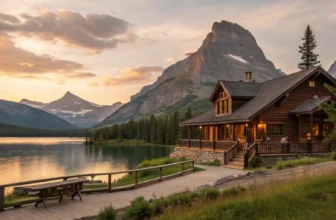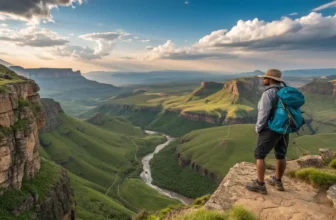

Salt on your lips, wind in your ears, and a horizon that refuses to sit still—that’s where 2026 begins. After years of crowded feeds and shrinking attention, you crave the kind of wonder that rearranges your pulse: lantern-lit nights, ancient footsteps, wild light across unbroken skies.
Time feels faster, flights feel easier, and the world is whispering, go now, before memory outruns opportunity. This list isn’t about trophies; it’s a set of doorways—into courage, quiet, and stories you’ll carry for decades. Ahead lie routes that challenge, soothe, and surprise, plus practical guidance to help you choose one that changes you.
1. Antarctica – The Final Frontier

The air feels almost supernatural in Antarctica — crisp, silent, and charged with awe. As your expedition ship cuts through glassy waters scattered with ancient icebergs, the horizon dissolves into shades of blue and white. Towering glaciers rise like cathedrals of frozen time. Penguins waddle fearlessly near your boots while whales breach in slow motion just offshore. It’s less a destination and more a transformation — standing there, you’re not a tourist but a humble guest in Earth’s most untouched wilderness.
One moment stays with many travelers: the first time the Zodiac boat glides silently past a colony of Adélie penguins, the wind carrying nothing but the crackle of distant ice. Every sound — every gust — feels magnified, as if the planet itself is whispering. You leave understanding that Antarctica doesn’t just exist at the edge of the world — it exists at the edge of human comprehension.
Key Practical Information
- Peak/Off-peak Seasons: December–February offers 24-hour daylight and easier sea crossings; expect −2°C to 8°C.
- Getting There: Fly from Punta Arenas (Chile) or Ushuaia (Argentina) to King George Island, then board an expedition ship.
- Ideal Duration: 10–14 days for immersive exploration.
- Must-Try Experiences: Zodiac cruising among icebergs, penguin colony landings, kayaking in polar waters, and the polar plunge.
- Budget: High-end expeditions range from $8,000–$15,000+ per person.
- Cultural Etiquette: Respect wildlife distance rules; nothing can be left or taken — Antarctica belongs to everyone and no one.
- Photography Opportunities: Ice caves, whale breaches, and surreal sun halos during midnight light.
2. Machu Picchu, Peru – Lost City in the Clouds

At sunrise, Machu Picchu appears like a mirage — emerald terraces rising above mist-wrapped peaks. The first light spills across the ancient stones, and you can almost hear the echoes of Incan chants whispering through the valley. The sheer precision of the architecture, carved without modern tools, feels like a triumph of both faith and engineering. Every step along the Inca Trail tells a story older than history books — a pilgrimage to a place where time seems to pause.
One traveler described the moment the fog lifted as “watching a civilization breathe again.” Whether you arrive via the legendary four-day Inca Trail or the scenic train from Cusco, Machu Picchu rewards patience and reverence. Standing atop the Guardhouse viewpoint, you sense both the ingenuity and humility of a people who lived in harmony with the mountains.
Key Practical Information
- Peak/Off-peak Seasons: Dry season (May–October) is best; expect cool, sunny days. Rainy months (Nov–Apr) bring lush greenery but slippery paths.
- Getting There: Fly to Cusco, take the train to Aguas Calientes, then ascend by bus or hike.
- Ideal Duration: 2–3 days (with optional Inca Trail extension).
- Must-Try Experiences: Sunrise view, Huayna Picchu hike, and local Peruvian cuisine — try alpaca steak or chicha morada.
- Budget: Moderate to high — around $1,500–$3,000 including permits and guided treks.
- Cultural Etiquette: Greet locals with a smile or “Allillanchu” (Quechua for hello). Avoid touching ruins unnecessarily.
- Photography Opportunities: Dawn mist, terraced fields, llamas grazing against ancient stone walls.
3. Galápagos Islands, Ecuador – Nature’s Living Laboratory

Few places on Earth feel as alive as the Galápagos. Each island hosts its own universe — marine iguanas bask on lava rocks, blue-footed boobies perform their comical mating dance, and sea lions laze beside your snorkeling fins. The magic lies in the trust of its wildlife — they’ve evolved without fear of humans. You’re not just watching nature here; you’re coexisting with it.
Sailing between islands, you grasp why Darwin’s theory of evolution was born here. Every day reveals something miraculous: a baby tortoise hatchling, a volcanic vista, or a playful sea lion twirling in turquoise water. The experience lingers long after you leave — a reminder of what the planet looks like when left to thrive.
Key Practical Information
- Peak/Off-peak Seasons: December–May (warm, calm seas, best snorkeling); June–November (cooler, more wildlife activity).
- Getting There: Fly via Quito or Guayaquil to Baltra or San Cristóbal Island; travel by liveaboard cruise or inter-island ferries.
- Ideal Duration: 7–10 days for multiple island stops.
- Must-Try Experiences: Snorkeling with sea turtles, hiking volcanic isles, and visiting the Charles Darwin Research Station.
- Budget: Mid to high — from $2,500–$6,000 depending on cruise class.
- Cultural Etiquette: Follow strict conservation rules — no touching animals, no flash photography, and always stay with your guide.
- Photography Opportunities: Close-ups of endemic species, lava fields, and sunsets reflected on pristine waters.
4. The Great Barrier Reef, Australia – The Heartbeat of the Ocean

Diving beneath the surface of the Great Barrier Reef feels like entering a cathedral made of color and light. Coral formations swirl like mosaics, and every movement — a parrotfish nibble, a turtle glide — unfolds in vivid detail. Despite climate challenges, parts of the reef remain breathtakingly vibrant, reminding us why it’s one of the planet’s most vital ecosystems.
Even from above, through the window of a seaplane, the reef’s turquoise ribbons stretch endlessly. Between dives, you can rest on white-sand cays or visit Indigenous-led tours that share ancient connections to “Sea Country.” The reef is not only a natural wonder — it’s a living teacher, urging us to protect what sustains us.
Key Practical Information
- Peak/Off-peak Seasons: June–October offers best visibility (25°C–29°C). Avoid January–March cyclone risks.
- Getting There: Fly into Cairns, Port Douglas, or Airlie Beach. Access via reef tours or liveaboard vessels.
- Ideal Duration: 5–7 days for multiple dive sites.
- Must-Try Experiences: Snorkeling or scuba diving, helicopter reef flight, and Indigenous Dreamtime cruises.
- Budget: Mid to high — $2,000–$5,000 for full reef experience.
- Cultural Etiquette: Acknowledge Traditional Owners; eco-conscious travel is deeply valued.
- Photography Opportunities: Aerial reef formations, clownfish among anemones, and coral gardens at golden hour.
5. Serengeti & Ngorongoro Crater, Tanzania – Nature’s Grand Stage

Few experiences rival the raw majesty of the Serengeti. At dawn, the savannah stretches infinitely, painted in gold and shadow as lions yawn beneath acacia trees. The air thrums with life — wildebeest on the move, elephants in silent procession, and the distant cry of a fish eagle. Witnessing the Great Migration — millions of animals crossing rivers in instinctual rhythm — feels like watching the pulse of the Earth itself.
Then there’s Ngorongoro Crater — a collapsed volcano turned Eden, where every safari drive reveals a new wonder. You might lock eyes with a black rhino grazing or watch a Maasai herder guiding cattle across the rim’s misty slopes. It’s a world suspended between myth and reality.
Key Practical Information
- Peak/Off-peak Seasons: June–October (dry season, migration crossing); November–May (lush green scenery, fewer crowds).
- Getting There: Fly into Arusha or Kilimanjaro International Airport; access parks via 4×4 safari or guided tour.
- Ideal Duration: 6–8 days combining Serengeti and Ngorongoro.
- Must-Try Experiences: Hot air balloon safari, Maasai village visit, and crater rim picnic.
- Budget: Mid to luxury — from $3,500–$10,000+.
- Cultural Etiquette: Always ask before photographing locals; tipping guides is customary.
- Photography Opportunities: Sunrise silhouettes, wildlife close-ups, and aerial shots over the crater’s lush basin.
6. The Dolomites & Northern Italy Alps, Italy — “Opera in Stone”

Angle you won’t expect: treat the Dolomites like a living theater. At sunrise, alpenglow paints the limestone pink and the whole massif feels choreographed. Instead of chasing only the famous lakes, thread together WWI tunnels, mountain dairies, and Ladin-speaking villages where polenta and speck tell the real story.
Scenarios that make it special: a misty via ferrata before the crowds, bell chimes drifting over an alpine meadow, then a hut-to-hut stroll where your “check-in” is a slice of apple strudel. Finish with a twilight e-bike roll through vineyards in Alto Adige, ending in a tiny osteria where the owner pours Gewürztraminer like family.
Practical, at-a-glance:
- Sweet spot: late June–September (wildflowers, open huts); Sept–Oct for crisp hikes and larch gold. Winter brings world-class ski circuits.
- Move smart: rent a car (Dolomite passes), mix with cable cars + regional trains (Bolzano/Trento hubs).
- Time needed: 5–8 days (add Venice or Verona if you must).
- Spend guide: mid to high; save by sleeping in rifugi and using half-board.
- Etiquette micro-brief: greet with “Salve”/“Grüß Gott”; on trails, yield to climbers descending; pack out every scrap.
- Photo cues: Tre Cime at blue hour, larch forests in October, mirror-still Lago di Braies on a windless dawn.
7. Arctic Aurora Quest (Norway/Finland) — “Chasing Silence”

Angle you won’t expect: flip the script from “aurora trophy shot” to slow arctic living. Base in one village, learn to read space weather, and savor soundscapes: snow squeak at −20°C, distant husky barks, a kettle humming in a glass igloo while curtains of green ripple overhead.
Scenarios that make it special: a sauna-to-snow plunge and, right then, the sky explodes; a reindeer sled through blue twilight; or a dark-sky fjord cruise where the Milky Way competes with aurora. On a “quiet” night, photograph ice crystals on windowpanes—proof the Arctic rewards patience.
Practical, at-a-glance:
- Sweet spot: Sept–Mar (peak Jan–Mar for clear, cold nights).
- Move smart: fly Tromsø, Alta, Rovaniemi, then minibus/self-drive; book flexible aurora tours that chase breaks in cloud cover.
- Time needed: 4–6 nights to hedge weather.
- Spend guide: mid to high; trim costs with cabins + cook-in breakfasts; splurge one night on a glass-roof stay.
- Etiquette micro-brief: respect Sámi culture; ask before photographing people or lavvu camps; keep voices low in the wild.
- Photo cues: foreground snow birch or a red cabin, shoot vertical to catch corona bursts, keep exposures short to preserve aurora texture.
8. Beijing & The Great Wall, China — “Stone, Smoke, and Tea”

Angle you won’t expect: make it a crafts & courtyards journey. Beyond must-sees, linger in hutong tea houses, watch paper-cut masters, and trace the Wall at wild sections where swallows skim the battlements and the wind is the only guide.
Scenarios that make it special: dawn on Mutianyu before cable cars start, a calligraphy lesson in a scholar’s garden, midnight Peking duck where the chef carves skin like lacquer. End with incense curling at a hidden temple market, bargaining for a travel talisman.
Practical, at-a-glance:
- Sweet spot: Apr–May (spring bloom), Sept–Oct (crisp, golden hills).
- Move smart: subway for the city web; hire a driver for Jinshanling/Gubeikou; pre-book Wall entries.
- Time needed: 4–5 days (1–2 for the Wall).
- Spend guide: broad range; street eats keep it budget-friendly, private Wall hikes add cost but buy solitude.
- Etiquette micro-brief: a soft nǐ hǎo goes far; accept items with two hands; queues can be fluid—hold your spot calmly.
- Photo cues: telephoto for Wall ridge undulations, misty mornings, lantern-lit hutong alleys at dusk.
9. Peru’s Sacred Valley + Amazon — “Two Worlds, One Thread”

Angle you won’t expect: stitch Andean cosmology to rainforest biodiversity in a single arc. Start with weaving cooperatives in Chinchero, learn plant dyes, then swap altitude for the Amazon’s warm breath where leafcutter ants march like a living necklace.
Scenarios that make it special: sunrise Pisaq terraces all to yourself; a coca-leaf blessing from a Quechua elder; then a night float on an oxbow lake, your headlamp catching caiman eyes like embers. The through-line is reciprocity—mountains and jungle giving in different tongues.
Practical, at-a-glance:
- Sweet spot: May–Sept in Andes (dry, cool); Jun–Nov Amazon (lower water = easier wildlife spotting).
- Move smart: base Ollantaytambo/Urubamba, then fly Cusco → Puerto Maldonado/Iquitos for lodges.
- Time needed: 7–9 days split valley + jungle.
- Spend guide: mid; save with collectivos and local menus, allocate splurge to a responsible Amazon lodge.
- Etiquette micro-brief: ask before photos at markets/ceremonies; follow guide-only trails in rainforest.
- Photo cues: textile close-ups, Andean chacras at golden hour, Amazon macro (dart frogs, orchids) under diffused light.
10. Botswana’s Okavango & Beyond — “Water That Walks”

Angle you won’t expect: lean into quiet safari—tracking by mokoro (dugout canoe) where reeds tick the hull and elephant footprints fill with mirror water. It’s the continent’s pulse in slow motion, a wetland that arrives like a seasonal guest.
Scenarios that make it special: a walking safari at first light to read last night’s stories in sand; a bush tea stop where fish eagles duet; and a starlit camp where lions rumble like distant thunder. When the flood is right, channels appear where maps insist there’s land—magic by hydrology.
Practical, at-a-glance:
- Sweet spot: Jun–Oct (dry season, peak game, prime delta floods).
- Move smart: fly-in light aircraft to delta airstrips; blend mokoro, boat, and 4×4 for varied habitats.
- Time needed: 5–7 days across 2–3 concessions.
- Spend guide: generally high; hack costs with shoulder months and mixed lodge tiers.
- Etiquette micro-brief: voices low on drives; no standing in vehicles near wildlife; tip trackers and staff.
- Photo cues: eye-level mokoro shots, backlit dust in late afternoon, reflections of papyrus and sky.
11. Vietnam’s Ha Long Bay & Hidden North — “Emerald Water, Limestone Dreams”

What most travelers see: a cruise through Ha Long Bay’s famous karst peaks.
What the lucky few find: the quiet coves of Bai Tu Long Bay, where the only sound is your paddle breaking jade water. A fisherman waves from a floating village; his home sways with the tide, his smile easy and weather-carved. Later, up in Ninh Binh, nicknamed “Ha Long on Land,” rice paddies shimmer under the limestone cliffs while water buffalo wander through mist.
- Insider Loop:
- Arrive: Hanoi (stay for street-food chaos + egg coffee).
- Sail: choose an overnight junk into Bai Tu Long, not central Ha Long.Stretch: train south to Ninh Binh, cycle through Tam Coc caves.
- Stay: eco-lodges run by local families; budget $100 – $150/day.
Hidden Takeaway: Ha Long isn’t about limestone—it’s about rhythm: the slow breath of tides reminding you how little control we ever have.
12. Sri Lanka’s Cultural Triangle & Tea Highlands — “Island of Contrasts”

Forget the coastline (for now). The soul of Sri Lanka hums inland—Sigiriya’s rock fortress rising like a giant’s fist, frescoes still glowing from centuries of heat. At dawn, you climb through lion-paw gates, and the jungle mist swirls below like incense. Then the world shifts: tea hills roll into infinity, and trains wind through Ella’s Nine Arches Bridge, painting movement into stillness.
- Quick Notes (Tea-Stained & Truthful):
- Best months: Dec–Apr for the dry cultural north; Jun–Sept for tea country clarity.
- Move like locals: third-class train from Kandy → Ella—cheap, raw, real.
- Eat bold: kottu roti with extra curry leaves.
- Expect: $60–$100/day mid-range.
- Etiquette: right hand for food, shoes off in temples, patience in queues—it’s part of the melody.
Travel theme: resilience. After everything the island has endured—colonies, conflict, tsunami—it still welcomes you with tea, not tales of sorrow.
13. Réunion Island, Indian Ocean — “Volcano Meets Vanilla”

Most visitors can’t find Réunion on a map—and that’s precisely its charm. Here, you hike from lava fields to rainforests to snowy peaks all in a day. Locals speak French spiced with Creole, markets smell of vanilla pods, and Piton de la Fournaise, one of Earth’s most active volcanoes, glows under alien skies.
- Creative Snapshot (The 6 Senses Route):
- Feel: volcanic gravel crunching beneath boots in Pas de Bellecombe.
- Hear: drumming from a maloya street dance.
- Smell: bourbon vanilla drying on racks.
- See: Mafate Cirque, reachable only on foot or by helicopter.
- Taste: rougail saucisse with cold Phoenix beer.
- Balance: year-round 25–30 °C coast; cooler mountain nights.
Hidden Gem Truth: Réunion fuses Europe’s polish with Africa’s soul—a symbol of how travel blurs boundaries yet deepens identity.
14. Québec’s Nibiischii Wilderness, Canada — “Where the Sky Speaks Cree”

A thousand lakes mirror a thousand stars here. The Nibiischii territory, co-managed by the Cree Nation, stretches far beyond tourist maps—canoe routes older than any border. Nights bring loons calling through mist, and mornings bloom with silence that feels sacred.
Insider Story: a Cree guide named Annie teaches you to paddle without ripples. “That’s respect,” she says. Later, you share bannock by the fire, and the northern lights ripple across the lake like a story retold in color. You realize adventure doesn’t always roar—it sometimes whispers.
Traveler’s Sketch:
- Go: June–Sept (ice-free lakes, bear sightings).
- Get there: Fly to Chibougamau, rent 4×4 or floatplane.
- Stay: Cree-run eco-lodges; $150/night average.
- Essentials: bug net, humility, and time—at least 5 days.
- Respect: follow “leave no trace” and listen before you speak.
Conclusion:
In 2026, the world feels newly possible, and these fourteen journeys invite you to step through real thresholds—not just collect stamps. Each trip promises awe, intimacy, and a lesson in moving gently through places that existed long before us. Choose one, plan with intention, respect local rhythms, and give more than you take. Come home not only with photographs, but with a steadier compass and a story that keeps unfolding.






